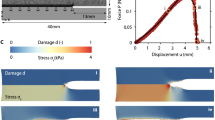Abstract
Arterial blood flow may be described as the almost periodic, unsteady-state flow of a non-Newtonian fluid through a flexible-walled, tapered, branching conduit. A generalized approach to the development of a realistic mathematical model is described. All assumptions involved in the analysis are evaluated critically in terms of their quantitative effect on the validity of the model. As a result some of the traditional assumptions are avoided. A numerical integration routine for obtaining solutions to the resulting nonlinear partial differential equations comprising the model is outlined. The possible application of the model to compute localized arterial wall elasticity is discussed. Successful implementation of this procedure could lead to a significant clinical diagnostic tool for vascular disease.
Similar content being viewed by others
Abbreviations
- a n ,b n :
-
constants in Equation (9)
- A, B :
-
constants in Equation (1)
- f :
-
general function notation
- i, j :
-
general incremental subscripts
- m, n :
-
constants in rheological equations (See Equations (2), (2a))
- n :
-
summation index in Equation (9) with upper limitN
- p :
-
fluid pressure
- P R :
-
fluid pressure at arterial wall
- r :
-
radial position
- R :
-
radius of artery
- t :
-
time
- u :
-
fluid velocity component inz direction
- v :
-
fluid velocity component inr direction
- z :
-
axial position
- Z :
-
length of arterial segment
- 0, 1, 2:
-
specific incremental subscripts.Greek Symbols
- \(\dot \gamma \) :
-
shear rate
- Δ:
-
finite increment such as ΔP, Δr, Δz, etc
- ε:
-
elasticity
- η:
-
non-Newtonian viscosity
- μ:
-
Newtonian viscosity
- π:
-
angle in radians
- ρ:
-
fluid density
- τ:
-
shear stress
- τ rr , τ rz , τ zz :
-
shear stress components as defined in Table 3
- ω:
-
fundamental frequency=2π/T, withT=the period
Literature
Akers, W. W., A. C. L. Barnard, H. M. Bourland, W. A. Hunt, W. P. Timlake and E. Varley. 1966. “Numerical Hydrodynamic Calculations of Catheter Characteristics.”Biophys. J.,6, 725–733.
Akers, W. W., 1967. Personal communication.
Barnard, A. C. L., W. A. Hunt, W. P. Timlake and E. Varley. 1966. “A Theory of Fluid Flow in Compliant Tubes.”Biophys. J.,6, 717–724.
—, 1966. “Peaking of the Pressure Pulse in Fluid-Filled Tubes of Spatially Varying Compliance.”Ibid.,6, 735–746.
Bird, R. B., W. E. Stewart and E. N. Lightfoot. 1960.Transport Phenomena. New York: John Wiley & Sons, 85.
———. 1960.Ibid., 103.
Charm, S. and G. Kurland. 1965. “Viscometry of Human Blood for Shear Rates of 0–100,000 Sec.−1”.Nature,204, (May 8), 617–618.
Distefano, G. P., F. P. May and C. E. Huckaba. 1967. “Transient Response and Feed-Forward Control of a Distillation Tower Subject to a Sequence of Upsets.”A.I. Ch. E. Jour.,13, 125–131.
Fairchild, B. T., H. R. Wengrow and F. P. May. 1965. “AMØS: Numerical Integration of Differential Equations with the Adams-Moulton-Shell Method.” Report published by Chemical Engineering Department, University of Florida (March).
—, L. J. Krovetz and C. E. Huckaba. 1967. “Digital Computer Simulation of Arterial Blood Flow.”Chemical Engineering in Medicine and Biology. D. Hershey, Ed. New York: Plenum Press, 3–43.
Hershey, D., R. E. Byrnes, R. L. Deddens and A. M. Rao. 1964. “Blood Rheology: Temperature Dependence of the Power Law Model.” Paper presented at A.I. Ch. E. Meeting, Boston (December).
Lapidus, L. 1962.Digital Computation for Chemical Engineers. New York: McGraw Hill, 135–140.
Merrill, E. W., E. R. Gilliland, G. Cokelet, H. Shin, A. Britlen and R. E. Wells, Jr. 1963. “Rheology of Human Blood Near and at Zero Flow; Effects of Temperature and Hematocrit Level.”Biophys. J.,3, 199–213.
Merson, R. H. 1957. “An Operational Method for Study of Integration Processes.”Proceedings of a Symposium on Data Processing. Weapons Research Establishment, Salisbury, South Australia.
Nevaril, C. G. 1966. “Mechanical Trauma to the Red Blood Cell.” Report No. 6607, Biomedical Engineering Laboratory, Rice University (October), p. 17.
Nordsieck, A. 1961. “On Numerical Integration of Ordinary Differential Equations.” Report R-127, Coordinated Science Laboratory, University of Illinois, Urbana (May).
Peterson, L. H. 1964. “Vessel Wall Stress-Strain Relationship.” InPulsatile Blood Flow, E. O. Attinger, Ed. Blakiston Division of McGraw-Hill Book Company, Chapter 15.
Reneau, D. D., D. F. Bruley and M. H. Knisely. 1967. “A Digital Simulation of Transient Oxygen Release, Diffusion and Consumption in the Capillaries and Tissue of the Human Brain.” Paper presented at A.I. Ch. E. Meeting, Houston, Texas (February).
Repetti, R. V. and E. F. Leonard. 1966. “Physical Basis for the Axial Accumulation of Red Blood Cells.” CEP Symposium Series No. 66, published by Amer. Inst. of Chem. Engineers, pp. 80–87.
Rudinger, G. 1966. “Review of Current Mathematical Methods for the Analysis of Blood Flow.” Amer. Soc. Mech. Eng. Biomedical Fluid Mechanics Symposium, Denver, Colorado (April 25–27).
Author information
Authors and Affiliations
Rights and permissions
About this article
Cite this article
Huckabe, C.E., Hahn, A.W. A generalized approach to the modeling of arterial blood flow. Bulletin of Mathematical Biophysics 30, 645–662 (1968). https://doi.org/10.1007/BF02476681
Received:
Issue Date:
DOI: https://doi.org/10.1007/BF02476681




